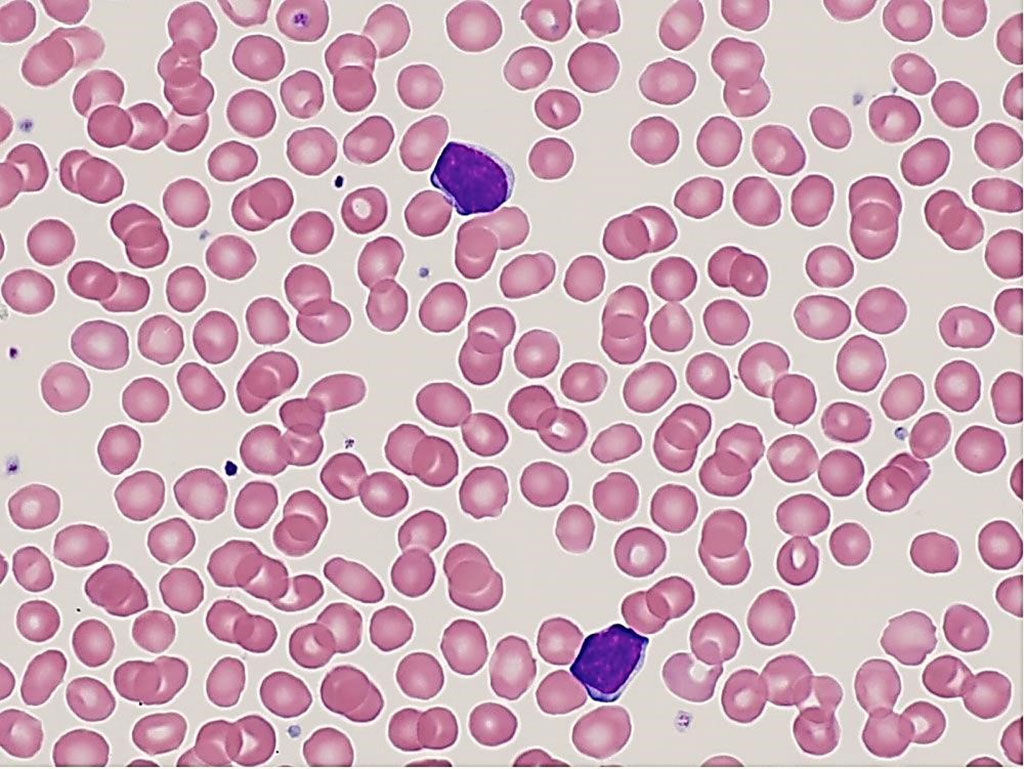Tissue Counterpart to Monoclonal B-Cell Lymphocytosis Characterized
By LabMedica International staff writers
Posted on 27 Dec 2021
Monoclonal B-cell lymphocytosis (MBL) was initially proposed to recognize patients with a monotypic B-cell population identified by peripheral blood (PB) flow cytometry (FC) that did not meet numerical criteria for chronic lymphocytic leukemia (CLL). Posted on 27 Dec 2021
While MBL is defined in the blood, pathologists encounter rare cases in which a monotypic B-cell population is detected in biopsy tissue undergoing FC without obvious morphologic involvement by lymphoma. B-cell clones discovered in tissue biopsies, without overt lymphoma, may represent a tissue counterpart to peripheral blood monoclonal B-cell lymphocytosis (MBL), herein termed tMBL.

Image: Blood film from a patient with Monoclonal B-cell lymphocytosis. The circulating atypical lymphocytes are mature with a small rim of basophilic cytoplasm. Monoclonal population of B cells in the blood is less than 5 ×109/L (Photo courtesy of Elizabeth Courville, MD)
Hematopathologists at the Cleveland Clinic (Cleveland, OH, USA) searched for all cases from 2009 to 2019 with FC analysis demonstrating a monotypic B-cell population in which a corresponding lymphomatous infiltrate was not evident by re-review of the routine hematoxylin-eosin (H&E)–stained sections. Flow cytometry was performed in-house on 31 cases (BD FACSCanto, BD Biosciences, San Diego, CA, USA). At a minimum, all cases had immunohistochemical (IHC) stains for CD3, CD5, CD19, CD20, lymphoid enhancer-binding factor 1 (LEF1), and cyclin-D1. In cases with a clinical history of a CD10+ lymphoma, immunostaining with CD10, BCL2, and BCL6 was also performed.
The scientists reported that 54 cases were identified (35 lymph node, three splenic, and 16 soft tissue/viscera). Forty-six cases were chronic lymphocytic leukemia (CLL)-type, two were atypical CLL, and six were non-CLL. tMBL was detectable by immunohistochemistry in 14 cases (26%, all CLL-type). Concurrent blood flow cytometry, available in 10 cases, showed four with low-count MBL (three CLL-type, one with non-CLL–type), five with high-count MBL (all CLL-type), and one case negative for clonal population. With median follow-up of 51 months, two patients had progression of disease (CLL, 68.7 months; and diffuse large B-cell lymphoma, 5.9 months). Patients with immunohistochemistry-detectable tMBL had increased monoclonal B cells per total lymphocyte events, morphologic evidence of bone marrow involvement, higher white blood cell count, and increased absolute lymphocyte count.
The authors concluded that tMBL spans an immunophenotypic spectrum similar to MBL, is detectable by immunohistochemistry in a minority of cases (often CLL immunophenotype), and is likely systemic in most cases. Development of overt lymphoma is uncommon but may occur, warranting clinical follow-up. The study was published in the December 2021 issue of the journal Archives of Pathology and Laboratory Medicine.
Related Links:
Cleveland Clinic
BD Biosciences














